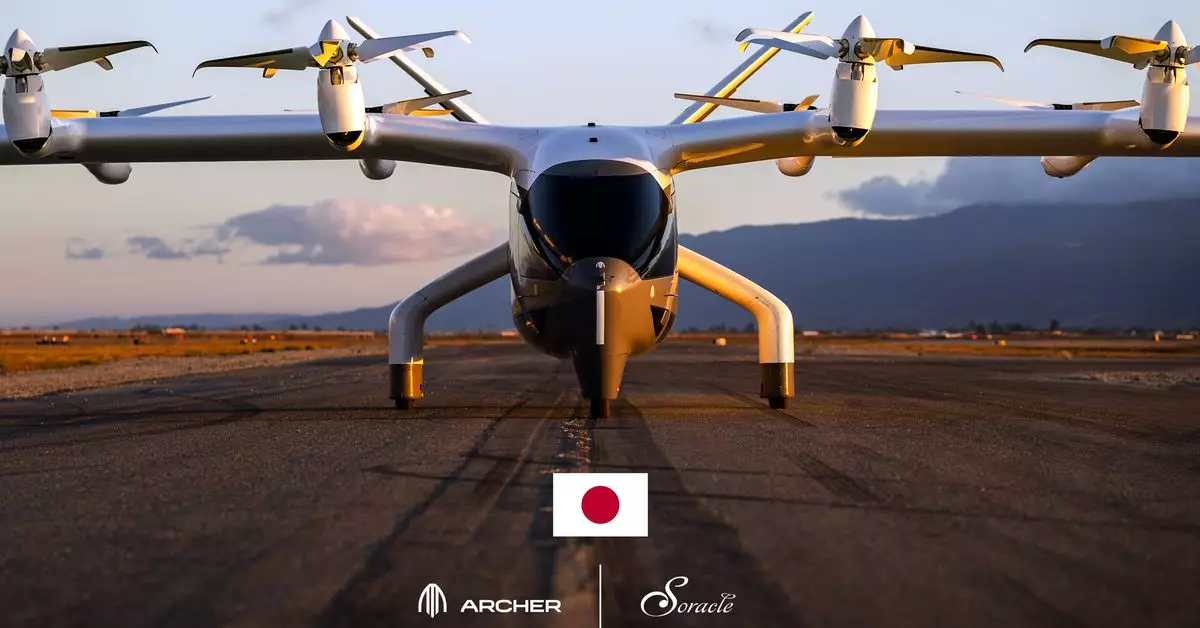The world of transportation is experiencing a seismic shift brought on by advancements in electric flight technology, and leading the charge is Archer Aviation. Based in San Jose, California, Archer is set to revolutionize urban air travel with its innovative air taxi concept. In a recent announcement, the company revealed a groundbreaking deal to supply 100 of its electric Midnight aircraft to Soracle, a new joint venture formed by Japan Airlines and Sumitomo Corporation. This deal, valued at approximately $500 million, marks a significant milestone not only for Archer but also for the entire aviation industry.
Archer’s Midnight aircraft, which can be described as a hybrid between a helicopter and a drone, is engineered for short-distance urban flights. Capable of carrying one pilot and up to four passengers, it boasts a commendable range of 100 miles (around 160 kilometers) and can reach speeds of approximately 150 mph (241 km/h) on battery power. Designed for a seamless urban operation, the Midnight engages a tilt-rotor system, enabling it to take off and land vertically, similar to a helicopter, and transition into horizontal flight like a fixed-wing aircraft. This innovative design aims to alleviate the burden of congested urban landscapes, a challenge that many metropolitan areas face today.
The partnership between Archer and Soracle is strategic not only in its financial implications but also in its potential to accelerate the approval processes required for commercial air taxi operations. While the deal is poised to enhance Archer’s trajectory towards launching services worldwide, it is subject to achieving specific milestones related to aircraft delivery and regulatory compliance. Archer has committed to cooperating with Soracle and the Japanese Civil Aviation Bureau (JCAB) to secure the necessary permissions, thereby underscoring the complexity and importance of regulatory approval in the aviation sector.
Recently, Archer received a Part 135 air carrier certification from the U.S. Federal Aviation Administration (FAA), a critical step toward operating its on-demand air taxi services. Furthermore, Archer is in the process of obtaining a type certification for the Midnight aircraft, ensuring it meets the FAA’s stringent design and safety standards.
Archer’s ambitious plans align with a burgeoning trend in the electric vertical takeoff and landing (eVTOL) space. With a growing order book, including $1 billion from United Airlines, Archer is positioning itself among the key players in a field that includes other prominent companies such as Joby Aviation, Volocopter, and Beta Technologies. Each of these organizations is racing against time to gain regulatory approval and launch their respective services.
The recent release of new FAA regulations for eVTOL vehicles has fortified the path to operational compliance, providing much-needed clarity to companies striving to navigate the regulatory landscape. Archer has lauded the FAA for delineating a clear operational framework, which is critical for advancing air travel.
While the steps forward for Archer and its competitors are promising, the eVTOL industry is not without its pitfalls. Companies are vying for a place in an emerging market that is fraught with challenges, including the high costs of development, regulatory obstacles, and public acceptance of new forms of air travel. The contrast is stark when looking at setbacks faced by organizations such as Lilium, which recently reported insolvency issues within two of its subsidiaries, casting a shadow over the competitive landscape.
The concept of air taxis can sometimes be misinterpreted as “flying cars,” however, the reality is far more nuanced. The future of urban air mobility encompasses advanced aircraft that are designed not only to be quieter and greener than traditional helicopter services but also to operate efficiently within urban environments hindered by ground traffic.
As Archer Aviation embarks on this ambitious journey towards reshaping urban air transport in Japan and beyond, stakeholders in the aviation sector will be watching closely. Archer’s developments will undoubtedly play a crucial role in determining the viability and acceptance of electric air taxis as a standard mode of transportation in the near future. Ultimately, the success of these innovative vehicles will not only depend on technological advancements but also on effective regulatory frameworks, strategic partnerships, and the willingness of the public to embrace this new frontier in mobility.


Leave a Reply